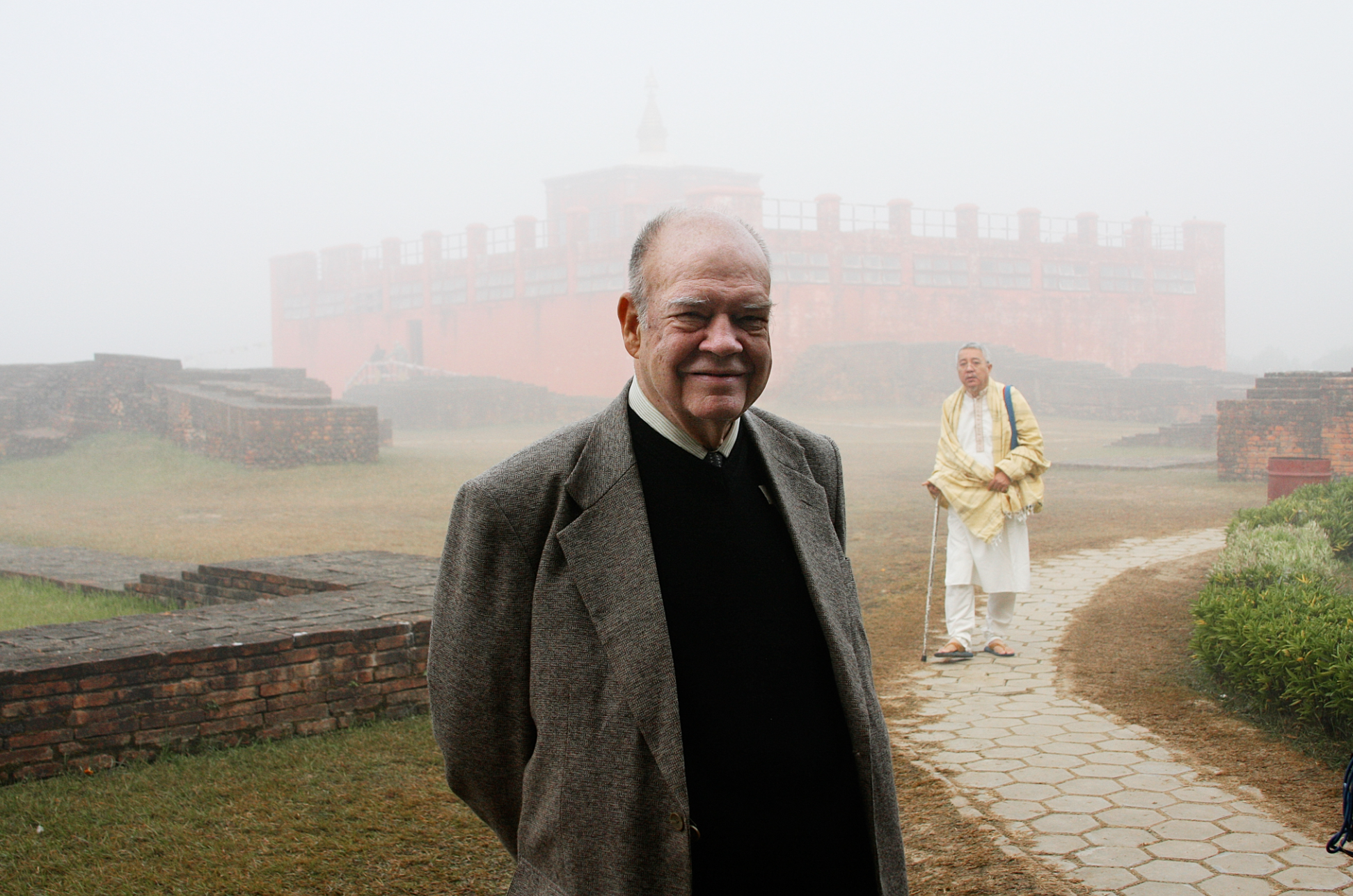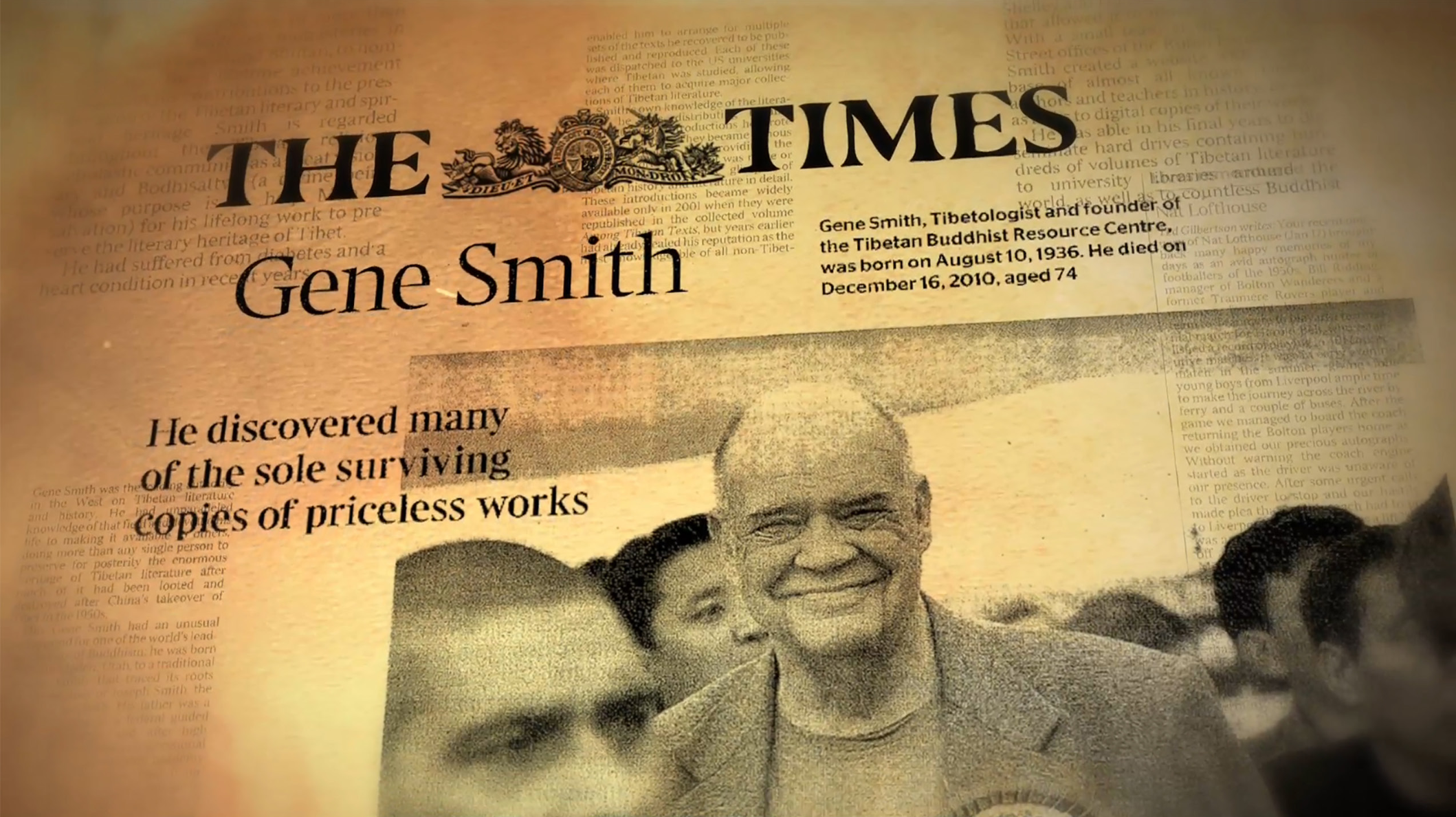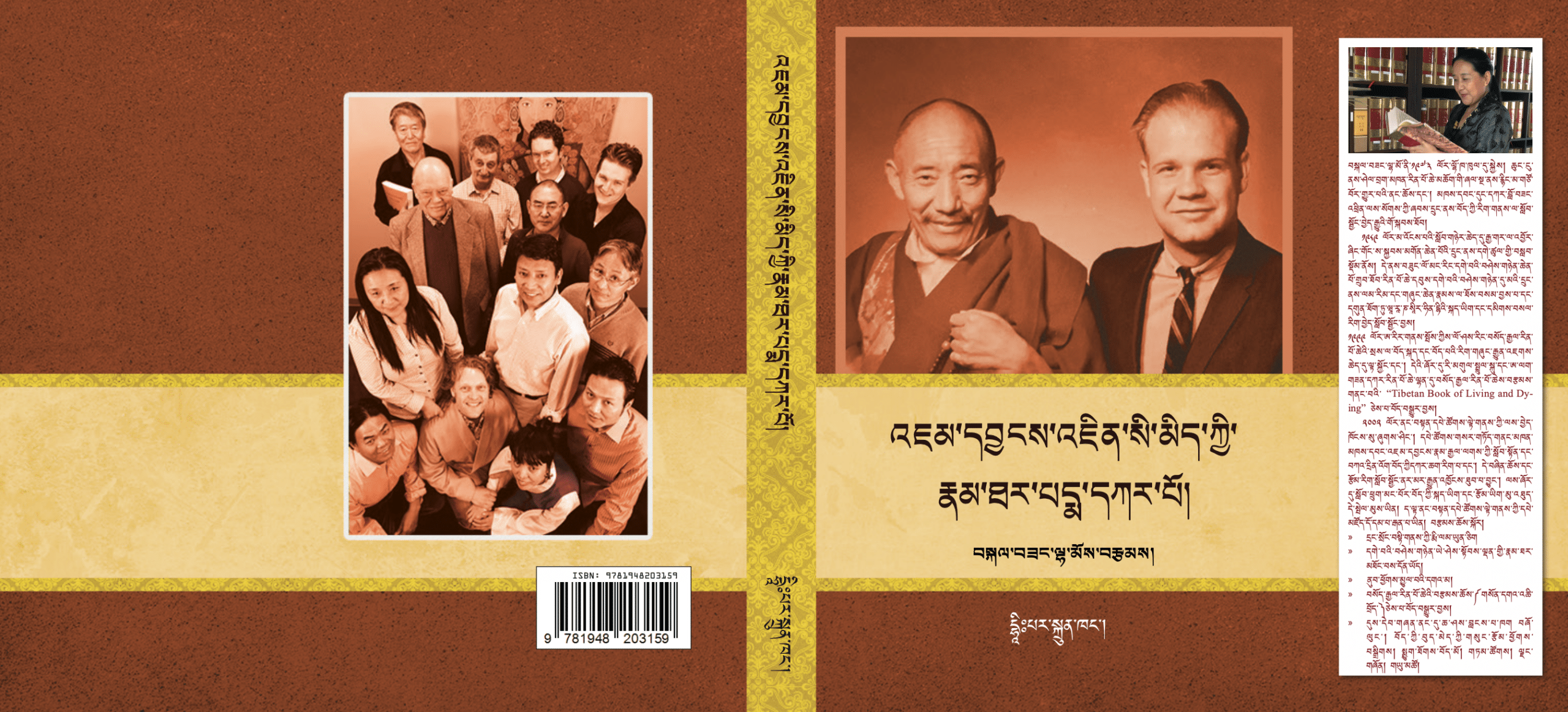
BDRC Founder E. Gene Smith (August 10, 1936–December 16, 2010). Photo from Digital Dharma: Recovering Wisdom, a photography book about Gene published by Wisdom Publications.
Our founder Gene Smith was a legendary scholar and advocate for Tibetan Buddhist literary culture, and the library that he founded—the Buddhist Digital Resource Center—has become the largest online Buddhist library in the world, preserving and sharing Buddhist literature with readers and users all over the world.
In many ways, Gene saw the future. He saw how technology could revolutionize Buddhist preservation and he sought to realize a future where the sacred wisdom of Buddhist Asia would be forever preserved and always accessible, for free, for all time.
Earlier this year, our Senior Librarian Kelsang Lhamo published her Tibetan-language biography of Gene, The White Lotus Biography of Jamyang Gene Smith, which is the first full portrait of Gene's remarkable life. Kelsang Lhamo worked closely with Gene from the earliest days of the Tibetan Buddhist Resource Center, and saw the organization grow from a tiny outfit to the sophisticated institution that it is today. Please see a short excerpt from this book below in both Tibetan and English. Kelsang plans to publish a future English translation of this book, so stay tuned!
We honor our founder Gene Smith and we strive to uphold his vision. The Buddhist Digital Resource Center preserves Buddhist literature for the world.
 We are pleased to present an excerpt from the White Lotus Biography.
We are pleased to present an excerpt from the White Lotus Biography.རྒྱ་གར་དུ་བཤེས་གཉེན་མཁས་པ་དུ་མའི་ཞབས་ལ་གཏུགས་རྗེས་་་དེ་ཚེ་འཇིན་ལགས་ཀྱི་ཐུགས་ལ། བོད་ཀྱི་ཆོས་དང་རིག་གནས་ནི་བླངས་པས་མཛད་མཐའ་མེད་པ་རྒྱ་མཚོ་ཆེན་པོ་ཆུ་བོའི་གཏེར་དང་འདྲ་ལ། ཟོས་པས་ངོམས་པ་མེད་པ་རོ་མཆོག་བརྒྱ་ལྡན་གྱི་ཟས་དང་སྒོ་ཀུན་ནས་མཚུངས་པས་ན། དེ་ཉིད་མཐིལ་ཕྱིན་པར་ཁོང་དུ་ཆུད་པར་བྱེད་དགོས་ན་ཡུན་བསྲིངས་ནས་དོན་གཉེར་བྱེད་དགོས་པ་ལས། ཟླ་ཤས་སམ་ལོ་འགའ་ཤས་ནང་སྦྱངས་ནས་ཤེས་པ་ཞིག་མི་ཡོང་བ་མཁྱེན་ཏེ། འབུམ་རམས་པའི་ལག་ཁྱེར་ནི་ཁ་ཚ་དགོས་བཏུགས་ཀྱི་དགོས་པ་ཞིག་མིན་དགོངས་ནས་ད་ལན་དངོས་སུ་འབུམ་རམས་པའི་ཕྱག་ཁྱེར་བཞེས་རྒྱུ་ཡོངས་སུ་བློས་གཏོང་གནང་སྟེ། མུ་མཐུད་རྒྱ་གར་དུ་བཞུགས་རྒྱུར་ཐུགས་ཐག་གཙང་བཅད་གནང་།
བཤེས་གཉེན་མཁས་པ་དང་གསུང་རབ་འཚོལ་བ་ལ་རྒྱ་གར་དང་། འབྲུག བལ་ཡུལ་གྱི་མཐའ་མཚམས་ས་ཁུལ་གང་སར་མ་ཕེབས་པའི་ས་ཞིག་མེད་པ་ལྟ་བུར་གྱུར། དེ་ནི་འདི་ལྟར་སྣང་སྟེ། གནའ་དུས་སུ་འཕགས་པའི་ཡུལ་ན་ཤེས་ལྡན་པ་རྣམས་ལེགས་བཤད་ཚིགས་བཅད་གཅིག་འཚོལ་བའི་དོན་དུ་རང་གི་ལུས་སྲོག་ནོར་དང་བཅས་པ་ཕངས་པ་མེད་པར་བཏང་ནས་གནས་ངེས་མེད་དུ་མྱུལ་བ་དང་ཕྱོགས་ཀུན་ནས་མཚུངས།
དེའི་ཚེ་གཙོ་བོར་ཀ་རྡོར་སྒང་གསུམ་(ཀ་ལོན་སྦུག རྡོ་རྗེ་གླིང་། སྒང་ཏོག་གསུམ) གྱི་ཁུལ་དང་ལྷག་པར་དུ་སྒང་ཏོག་གམ་འབྲས་ལྗོངས་ཁུལ་དུ་ཡོད་པའི་སྒེར་པ་ཆེ་གྲས་ཀྱིས་གཅེས་གསོག་གནང་བའི་བོད་ཀྱི་གསུང་རབ་རྣམས་ཡིན། ལྷག་པར་ཐུགས་ཕན་སོས་ཤོས་ཤིག་ནི་འབྲས་ལྗོངས་མི་རྗེ་འབའ་ཉག་ཨ་མཐིང་༼༡༩༩༢-༡༩༨༨༽ དང་འབྲེལ་འདྲིས་བྱུང་ཞིང་། དཔེ་དཀོན་དུ་མས་ཕྱུག་པའི་ཁོང་གི་དཔེ་མཛོད་ཁང་དུ་གཟིགས་རྟོགས་ཞིབ་ཅིང་ཕྲ་བ་དང་། ཧ་ཅང་གལ་ཆེ་བའི་དཔེ་དཀོན་རིགས་རྣམས་ངོ་བཤུས་གནང་བ་ནི། དབུས་གཙང་ཁུལ་དུ་བཞུགས་པའི་ཤིང་པར་གྱི་དཀར་ཆག ཞོལ་པར་ཁང་གི་བཀའ་འགྱུར་དཀར་ཆག འབྲས་སྤུངས་དགོན་པའི་ཤིང་པར་དཀར་ཆག འབྲས་སྤུངས་དགའ་ལྡན་ཕོ་བྲང་གི་ཤིང་པར་དཀར་ཆག ཨ་ཁུ་ཆིང་ཤེས་རབ་རྒྱ་མཚོའི་དཔེ་ཐོ་སྟེ། <<དཔེ་རྒྱུན་དཀོན་པ་འགའ་ཞིག་གི་ཐོ་ཡིག་དོན་གཉེར་ཡིད་ཀྱི་ཀུནྡ་བཞད་པའི་ཟླ་འོད་འབུམ་གྱི་སྙེ་མ།>> ལ་སྟོད་དིང་རི་ཆོས་རྒྱལ་གྱི་ཤིང་པར་དཀར་ཆག རྩིབས་རི་པར་མའི་དཀར་ཆག བོད་ཤར་ཕྱོགས་སུ་བཞུགས་པའི་ཤིང་པར་དཀར་ཆག གཞན་ཡང་པར་དུ་མ་འཁོད་པའི་ས་སྐྱ་དགོན་ཆེན་གྱི་དཀར་ཆག་བྲིས་མ་སོགས་མཛུབ་སྣོན་ལྕགས་པར་བསྐྱོན་ནས་ཆ་ཚང་བ་སྨར་བཤུས་དང་། དེ་ནས་རིམ་པར་མ་དཔེ་དེ་དག་ལ་གཞིར་བཟུང་ནས་ཕྱོགས་གང་སར་དཔེ་རྒྱུན་འཚོལ་བའི་ཐབས་ཤེས་ཡོད་རྒུ་རྩལ་སྤྲུགས་བཏོན་གནང་ཡོད།
– འཇམ་དབྱངས་འཇིན་སི་མིད་ཀྱི་རྣམ་ཐར་པདྨ་མ་དཀར་པོ་ནས་ཟུར་དུ་ཕྱུང་བ། WA8CZ275 pp.95-96
In India, Gene was very fortunate in meeting many scholars and learned masters from Tibet and had the chance to read and study the texts that they had brought with them. Gene realized that Tibetan wisdom and knowledge traditions were as vast as the ocean. Even if he studied for a few months or for a few years, he was only going to scratch the surface, that wasn't enough time to go deep. To truly go deep, he would have to spend his whole life on this endeavor. Therefore he decided to give up his PhD in order to stay in India and receive a real education in Tibetan Buddhist literature.
He traveled all over India, Nepal, and Bhutan and along their remote borders in search of teachers and texts, much as the early Indian Buddhist masters in olden times undertook great dangers and suffered personal hardship in order to seek even one verse of teachings or wisdom. He found a great many texts on his travels, especially among the wealthier families in Kalimpong, Darjeeling, Gangtok. Meeting Banyak Athing, also known as Rai Bahadur Densapa (1902-1988) [Tibetan actually says birth year was 1992] in Gangtok was especially helpful and fruitful for Gene. The scholar allowed Gene access to his personal library which had a great many rare texts, the most significant of which Gene was able to make copies of.
Among other texts, Gene made copies of the following: the Karchag catalog of blockprints in Central Tibet, the Catalog of the Shol Kangyur, the Karchag of the Drepung Monastery blockprints, the Karchag of the Ganden Phodrang at Drepung Monastery, the Karchag of blockprints of Eastern Tibet, Sherab Gyatso's catalog of rare texts, the catalog of texts at Sakya Monastery etc.
– Excerpted from The White Lotus Biography of Jamyang Gene Smith

The White Lotus Biography, a biography of Gene Smith in Tibetan language by Kelsang Lhamo, was published in March 2023.





Sorry, the comment form is closed at this time.